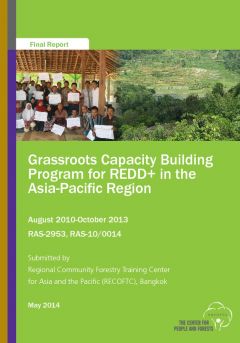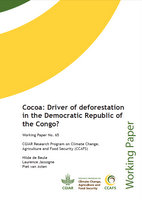Giới thiệu Dự án xây dựng năng lực cấp cơ sở về REDD+ tại Châu Á
Tờ thông tin giới thiệu phạm vi và phương thức tiếp cận dự án. Kể từ năm 2009, RECOFTC đã và đang thực hiện dự án khu vực về xây dựng năng lực cấp cơ sở cho REDD+ thông qua hỗ trợ của Norad với mục đích thúc đẩy sự tham gia hiệu quả của nhiều bên liên quan đa dạng cấp cơ sở trong cuộc đối thoại khu vực Châu Á - Thái Bình Dương về BĐKH và REDD+.
Grassroots Capacity Building for REDD+ in Asia Project Final Report 2010-2013
This is the final report of the “Grassroots Capacity Building for REDD+” project in the Asia-Pacific region. The report highlights key achievements and impacts of the project, implemented in four countries—Indonesia, Lao PDR, Nepal and Vietnam between August 2010 and July 2013 in partnership with a total of 18 organizations.
Current Status of Social Forestry in Climate Change Mitigation and Adaptation in the ASEAN region
This report covers eight ASEAN countries (Cambodia, Indonesia, Lao People’s Democratic Republic, Malaysia (particularly the state of Sabah), Myanmar, Philippines, Thailand and Viet Nam). The report examines the current status of social forestry in climate mitigation and adaptation in the Association of Southeast Asian Nations (ASEAN), and aims to update the Initial Baseline Assessment on Social Forestry and Climate Change published in 2010.
Grassroots Capacity Building for REDD+ in Asia Project Annual Report 2013
This annual progress report highlights key achievements and lessons learned of the “Grassroots Capacity Building for REDD+” project in the Asia‐Pacific region in 2013.
Institutional factors affecting wild edible plant (WEP) harvest and consumption in semi-arid Kenya
Pervasive food insecurity and poverty in much of the world drives vulnerable populations to harvest natural resources as a means of generating income and meeting other household needs. Wild edible plants (WEPs) are a particularly common and effective coping strategy used to increase socio-ecological resilience in Sub-Saharan Africa where agricultural systems are often sensitive to environmental perturbations and instability. WEPs are collected across the landscape, from agricultural areas to government-managed hilltops with varying degrees of success and legality.
Cocoa: Driver of Deforestation in the Democratic Republic of the Congo?
The Democratic Republic of the Congo (DRC) accounts for the largest part of the Congo Basin forest: two-thirds (some 155 million hectares) are forested and 69 percent of which is dense humid forest. With a surge in world market commodity prices for cocoa in 2008 and a steady 2-5% annual increase in global demand, incentives to expand cocoa production are significant. This study determines the role of cocoa in the RDC in terms of current deforestation, identifies actors, and estimates future expansion.
Myanmar Ecological Forecasting: Utilizing NASA Earth Observations to Monitor, Map, and Analyze Mangrove Forests in Myanmar for Enhanced
... Mangrove forests are one of the most valuable, thriving, and diverse ecosystems on the planet, but they are becoming increasingly exploited and mismanaged (Lee 1999; Giri et al. 2008). In Myanmar, many of these mangrove stands flourished for centuries, virtually untouched until extensive deforestation began in the late 1970’s. At the time there was no legislation to promote sustainable forest management, and as a result the forests were depleted at alarming rates.
Assessing community-based natural resource management effectiveness in Siem Reap province, Cambodia
Community forestry (CF) and Community Protected Areas (CPA) have been established for well over a decade in Siem Reap province. The study investigates the socioeconomic benefits gained by CPA and CF members from their participation in Community-Based Resources Management CBNRM. In CBNRM, local communities are responsible for the management of local resources. However, many CBNRM initiatives in Cambodia are more controlled by government than by communities. The report analyzes and compares two communities and the results of their CBNRM practices.
The role of Community Forests in REDD+ implementation; Cases of Thailand and Myanmar
Overview: • Definition of CF and its significance to
REDD+ objectives
• CF in Thailand and Myanmar
- Background &Characteristics
- Existing challenges
• Connecting CF and REDD+
• REDD+ progresses in Thailand and
Myanmar
• Risks and Opportunities to CF
Decision No. 512/QD-TTg approving the master plan on socio-economic development of Cao Bang province through 2020, with a vision toward 2025.
This Decision approves the master plan on socio-economic development of Cao Bang province through 2020, with a vision toward 2025 (below referred to as the master plan) with the following principal contents: 1. The master plan on socio-economic development of Cao Bang province through 2020, with a vision toward 2025 must conform to the national socio-economic development strategy, the master plan on socio-economic development in the northern midland and mountainous region and ensure consistency with the sectoral development master plans. 2.
A Study of the Role of Forest and Forest-Dependent Community in Myanmar
... This study was intended to find out the benefits of forests, especially for non-wood forest products (NWFPs), to forestdependent local people and the relation to their socio-economic status. Sampling (169 respondents) was chosen to be an equal distribution of household’s economic status. The survey was conducted face to face with structural interviews using both open-and closed-ended questions. The results showed that bamboo and bamboo shoot were considered as the most collected NWFPs in the Bago Yoma region.










